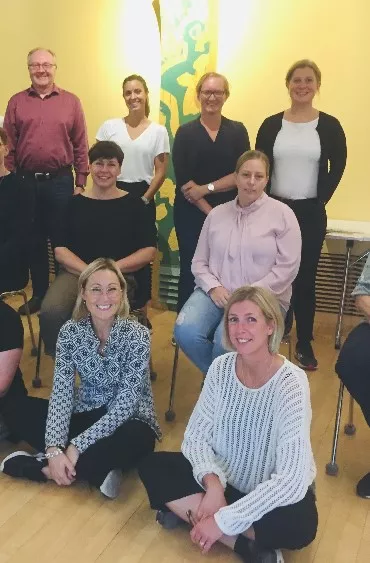" Innovation is not all about technology, it can also refer to new ways of education. In this case about death. The topic might be controversial but is still an important one for healthcare. Read the conversation between the nominee Judy Laurin and the Innovation hub’s Lisa Norén. "
Hi Judy! You are one of the Ramsay Santé Capio caregivers nominating a project to the Innovation Award 2022. Where do you work?
I work at “Capio Elderly and mobile care”, in an Advanced home care unit north of Stockholm, Sweden. Our multi-professional team cares for people with life-limiting and chronic diseases, for example, cancer, ALS, or heart failure, and helps them to obtain holistic care and symptom relief in their homes or our care wards. I am a nurse specializing in palliative care but also work with quality co-ordinations, Linda Martinson is the manager of our unit and Sofia Wiegurd is one of the doctors working with us.
What is ”Last aid”, and how did you get to hear from it?
“Last aid” is a structured concept lecture about death and dying, produced by Georg Bollig, a German doctor with the purpose to teach both next-of-kin as well as the public about this natural but somehow still uncomfortable topic. It contains four standardized blocks for a 4-hour lecture: death and the dying process, planning and wishes for social support, available symptom relief and how a fellow human can help, and the aftermath with a focus on funerals and sorrow.
Linda had heard about it and contacted dr Bollig, and was directed towards Österlenstiftelsen, who had recently translated the material to Swedish and were just starting to educate in Sweden. We all felt we wanted to do this, it was spot on something we believed was lacking in health care. So, we took the course and learned how to use the material.
I have been managing the project, regarding marketing, invitations, and contact with the participants, as well as evaluating and compiling the results afterward.
What happened then?
We spread the word about the lecture on our social media channels and held our first course in the spring of 2021. We had been planning for a physical meeting, but due to the second pandemic wave, we had to switch to a digital one. We were uncertain about how many participants we could welcome to the lecture, so we were a bit careful at first. We learned from the first occasion that the audience preferred to listen rather than discuss, they seemed to like the anonymity. So we adjusted the planning. The lecture was shortened to 2,5 hours and for the next lectures, we allowed more participants to listen. They can still ask questions, but we do not strive for discussion and dialogue in the same way we had figured. It’s more like the three of us interacting as in a podcast, but it seems to be appreciated by the audience. Now we have held the lecture four times and reached out to about 40 people.
Who are the participants, and what do they say?
They can be next of kin, or just an interested public. But also people working in healthcare or community care.
We can see how the stigma around death is released, and how the participants feel more comfortable being around a dying person. In the evaluations, the listeners appreciated the content and the level of information. There is a surge for more information, but it’s a bit difficult to meet this with the limited time frame.
One person wrote: ”I believe a more thorough understanding of death and its consequences is crucial, both for patients and their relatives. Your work is important”. Wow, it felt good to read that.
What’s next?
We want to continue to do this, since we see that the educative part is important and rewarding, and we see that it helps both patients, their relatives, and the caregivers.
We will probably use a mixed approach and keep doing digital lectures, but we also look forward to having physical lectures in the auditorium in Sollentuna hospital.
But we wonder where the men are! We see a vast majority of female participants and need to find out how to reach the men. Should we adjust the information or the marketing? We need to find that out.
In autumn 2022, we will present our learnings at the Swedish Palliative care congress in Gothenburg, together with Palliativt Utvecklingscentrum in Lund and a scientific project from Österlenstiftelsen.
What is your greatest pride?
That we made it! After all, it’s an extra task on top of our other work assignments. But it’s been great teamwork!
Despite the challenges of the pandemic, we accomplished to be the first ones in Sweden to start this education on a steady basis. Death has become a contemporary topic during these last two years, so we feel that the timing was important.
We are also proud and grateful to our managers who supported us in this work. It makes it feel good to be Capio/Ramsay Santé.
Thank you!
Written by Elisabeth Norén
Ramsay Santé Innovation and partnership hub

